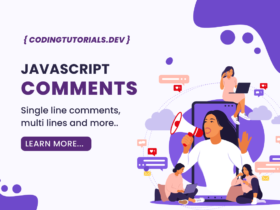If you’re a web developer, you’re likely already familiar with JavaScript Comments. If not, don’t worry! This comprehensive guide will provide you with a complete understanding of what they are, why they matter, and best practices for using them effectively.
Comments are an essential component of coding, helping to make your JavaScript code more readable, maintainable and collaborative. Our guide will provide you with all of the information you need to make the most of comments in your code.
Key Takeaways:
- JavaScript Comments are a vital component of coding
- Comments improve code readability, comprehension, and collaboration
- Proper commenting can enhance code efficiency and quality
- Best practices for writing comments include using clear and concise language, avoiding over-commenting, and documenting changes
- Common pitfalls to avoid include outdated, unclear, and unnecessary comments
What are JavaScript Comments?
JavaScript Comments are pieces of text inserted into your code that are ignored by the interpreter or compiler. They serve as documentation that helps explain the purpose of a particular section of code or as a temporary flag to disable a portion of code during testing or debugging.
Comments are an essential part of coding. They improve code readability, make it easier to understand, and help in collaborating with other developers. Without comments, code can become ambiguous and hard to decipher, even for the original author.
When it comes to commenting JavaScript code, it’s essential to follow best practices, be consistent, and document your code as accurately as possible.
Types of JavaScript Comments
While we covered the basics of JavaScript Comments in the previous section, it’s essential to understand the different types of comments you can use in your code. The type of comment you choose can affect code readability, organization, and documentation.
Single-line comments
Single-line comments start with two forward slashes (//) and are used to add comments to a single line of code. These comments are helpful for adding short descriptions or explanations of what a particular line of code does.
// This line of code increments the value of x by 1Multi-line comments
Multi-line comments start with “/*” and end with “*/”. These comments are used to write more extensive explanations and can span multiple lines. Multi-line comments are helpful for providing context to large blocks of code or documenting the purpose of an entire function.
/* This function calculates the sum of two numbers and returns the result. Parameters: - num1: the first number to add - num2: the second number to add Returns: the sum of num1 and num2 */Documentation comments
Documentation comments use a specific syntax to generate documentation automatically. These comments typically start with “/**” and contain specific keywords that can be parsed by documentation generation tools. While not required, documentation comments are often used in professional settings to generate API documentation.
/** * This function calculates the sum of two numbers and returns the result. * @param {number} num1 - The first number to add * @param {number} num2 - The second number to add * @returns {number} The sum of num1 and num2 */By using documentation comments, you can generate clear, professional documentation that is easy to read and understand.
Now that we’ve covered the different types of comments available in JavaScript, let’s move on to the syntax for writing comments.
Syntax for Writing JavaScript Comments
JavaScript comments are an essential tool for developers to write clear and well-organized code. Commenting code is also beneficial for future maintenance and documentation. In this section, we’ll cover the syntax for writing JavaScript comments in detail.
Single-line comments: Single-line comments are used to add a comment on a single line of code. Use double forward slashes (//) to begin a single-line comment. Anything after the two slashes will be ignored by the interpreter. For example:
// This is a single-line commentMulti-line comments: Multi-line comments are used to add a comment that spans over multiple lines of code. Enclose the comments with a forward slash and asterisk (/*) to begin a multi-line comment and an asterisk and backslash (*/) to end it. Any code between the symbols will be ignored. For example:
/* This is a multi-line comment */
Documentation comments: Documentation comments are used to generate documentation for your code. They are written in a specific format and can be parsed by tools like JSDoc. To begin a documentation comment, add two asterisks (**) before the comment. For example:
/**
* This function returns the sum of two numbers.
* @param {number} a - The first number
* @param {number} b - The second number
* @return {number} - The sum of a and b
*/It’s important to write concise, clear, and meaningful comments to make your code readable and maintainable. Avoid unnecessary comments and comments that restate the code. Use comments to explain complex code, assumptions, and trade-offs.
Best Practices for Writing JavaScript Comments:
- Use comments to explain why, not what the code does
- Write comments before the code, not after it
- Use proper grammar, spelling, and punctuation to make your comments readable and professional
- Avoid using abbreviations, jargon, or unclear terminology in your comments
Best Practices for Using JavaScript Comments
In order to use JavaScript Comments effectively, it is important to follow certain best practices. By doing so, you can ensure that your comments are clear, concise, and useful to anyone who might be working with your code.
Avoid Over-Commenting
While comments can be helpful, it is also possible to overdo it. Too many comments can actually make your code harder to read and understand. Instead of commenting every line of code, focus on adding comments where they are truly necessary. This will make it easier for others to follow your thought process and better understand the logic behind your code.
Write Clear and Concise Comments
When writing comments, it is important to be clear and concise. Try to keep your comments short and to the point, while still conveying the necessary information. Avoid using overly technical language or jargon that might be confusing to others who are not as familiar with the codebase. Instead, use plain language that is easy for anyone to understand.
Organize Your Code with Comments
Comments can be a great way to organize your code and make it easier to read and follow. Consider using comments to break up your code into smaller, more manageable sections. This can make it easier to locate specific parts of the code and can also make it easier to debug any issues that might arise.
Avoid Unnecessary Comments
While comments can be helpful, they can also be distracting if they are not truly necessary. Avoid adding comments that simply repeat what the code is already saying. Instead, focus on adding comments that provide additional insight or that help others understand the intent behind your code.
Document Changes in Code
As your codebase grows and evolves, it can be helpful to document any changes that are made. Adding comments when you make changes to your code can help others understand the reasoning behind those changes and can make it easier to maintain the code in the long run.
Commenting for Collaboration
Collaboration is a crucial aspect of coding, and well-placed comments can make collaboration among developers more efficient.
Commenting Conventions
Using a consistent commenting convention is essential for successful collaboration. By following the same commenting guidelines, developers can easily understand each other’s code. Some common conventions include:
- Using single-line comments for short descriptions and explanations
- Using multi-line comments for longer explanations and documentation
- Using documentation comments for functions, classes, and methods
- Starting comments with a capital letter and using proper grammar and punctuation
Using Comments as Reminders
Comments can also serve as reminders for developers. By leaving comments as notes to themselves or other developers, they can quickly get back up to speed on a particular code segment.
Example:
// TODO: refactor this code to use ES6 syntaxDocumenting Changes in Code
It’s essential to document changes in code to keep everyone on the same page. By commenting on changes that have been made, developers can easily see who made the change, why they made it, and when they made it.
| Date | Developer | Change Description |
|---|---|---|
| 12/01/2021 | John Doe | Updated function to improve performance |
| 12/05/2021 | Jane Smith | Added parameter to function to fix bug |
By following these best practices for commenting in JavaScript, you can enhance collaboration among developers, making the development process smoother and more efficient.
Commenting for Debugging
JavaScript Comments are not only helpful for understanding code but also vital for debugging. By strategically adding comments, you can isolate code that may be causing problems and assist other developers in identifying and solving issues.
One useful technique is to use comments to temporarily remove sections of code. You can then test the code to see if the issue persists. If the problem disappears, you’ve identified the source of the issue. If not, you can move on to another section of code and repeat the process. This technique can save valuable time when debugging complex code.
“Using comments to troubleshoot issues can be a game-changer, especially in large and complex applications.”
Another effective way to use comments for debugging is to add descriptive comments next to variables and functions. This can help you keep track of the purpose of each component, making it easier to spot errors. For example:
Code without comments
let x = 5;
function multiplyByTwo(num) {
return num * 2;
}
let result = multiplyByTwo(x);Code with comments
// Define a variable called x
let x = 5;
// Define a function to multiply a number by 2
function multiplyByTwo(num) { return num * 2; }
// Call the function with the value of x and store the result
let result = multiplyByTwo(x);In the example above, the comments make it clear what each section of code does, making it easier to identify any issues that may arise.
Comments can also be helpful when debugging in groups. By adding comments detailing the issue and potential solutions, other developers can quickly understand the problem and offer their insights. This collaborative approach saves time and promotes productivity.
In summary, comments are a powerful tool that can aid in debugging. By adding well-placed comments to your code, you can quickly isolate problems, keep track of variables and functions, and collaborate effectively with other developers.
Commenting for Maintenance and Documentation
Documentation and maintenance are critical to the success of any coding project. Without proper documentation, future updates and changes to the code can be difficult to implement. This is where commenting comes in as a valuable tool for maintaining code. By adding comments to your JavaScript code, you can make it easier for other developers to understand and work with your code.
Comments can also help with debugging by providing insights into the author’s intent. Here are some best practices to consider when adding comments to your JavaScript code for maintenance and documentation:
- Be clear and concise: Comments should be easy to read and unambiguous. Avoid using jargons and technical terminologies that may not be familiar to other developers.
- Organize your comments: Use consistent formatting throughout your code to make it easier for other developers to read and understand.
- Document your functions: Add comments above your functions that describe what they do, the parameters they take, and the values they return.
- Update your comments: As you make changes to your code, make sure to update any relevant comments accordingly.
Table 1 below shows an example of how to document a function:
| Function Name: | calculateSum |
|---|---|
| Description: | Calculates the sum of two numbers. |
| Parameters: | num1: The first number to be added.num2: The second number to be added. |
| Returns: | The sum of num1 and num2. |
By following these best practices, you can ensure that your code is well-documented and easy to maintain. When other developers can easily understand, modify, and add to your code, collaboration becomes much more efficient.
Commenting Pitfalls to Avoid
While it is crucial to use JavaScript Comments to improve your code, there is a risk of overdoing it or using them ineffectively. Below are some common Commenting Pitfalls to Avoid:
1. Over-Commenting
Adding too many comments can make your code harder to read. Avoid adding comments that simply describe what the code is doing. Instead, focus on explaining why you are using a particular approach or providing context for complex lines of code.
2. Outdated Comments
As the code changes, it’s essential to update the comments to reflect the current state of the code. Outdated comments can be misleading and lead to confusion or errors in understanding the code.
3. Unclear Comments
Your comments should be easy to understand and use clear and concise language. Avoid using technical jargon that may not be clear to everyone who reads it. Ensure your comments are accessible and can be understood by your collaborators.
4. Commented-out Code
Avoid commenting out code instead of deleting it when it is no longer required. This practice can clutter your code, making it harder to read and understand.
5. Too Many Abbreviations
While abbreviations can save time, they can also lead to confusion if they are not well-known or used inconsistently. Use abbreviations sparingly, and if you do use them, ensure they are clear and consistent throughout your code.
6. Inconsistent Commenting
Standardizing your commenting conventions is essential to ensure consistency across your codebase. If different developers use different commenting styles or practices, it can make code collaboration and maintenance challenging.
By avoiding these Commenting Pitfalls, you can ensure that your JavaScript Comments are efficient, clear, and helpful for you and your collaborators.
Tools and Extensions for Comment Management
If you want to optimize your JavaScript comment management, there are various tools and extensions available that can enhance your commenting process. These tools can help automate comment generation, validate comment formatting, and aid in comment navigation. Here are some popular tools you can consider:
- DocBlockr: A popular extension for Sublime Text and Visual Studio Code that automates comment generation for functions, methods, and classes by parsing your code. It also formats comments according to standards such as JSDoc and PHPDoc.
- ESLint: A popular linter that provides feedback on your code based on best practices and coding conventions. It has a plugin called eslint-plugin-jsdoc which can validate the compliance of your JSDoc comments.
- Comment Anchors: An extension for Visual Studio Code that allows you to create named anchors for your comments. This enables easy navigation and reference to specific comments within your code.
- CodeStream: A collaboration tool that enables inline commenting and code reviews. You can use this tool to comment on specific lines of code, reply to comments, and track changes in code over time.
Choosing the right tool
When choosing a tool for comment management, it’s important to consider your specific needs and preferences. Look for a tool that aligns with your coding practices and provides features that are relevant to your workflow. You can also experiment with different tools and extensions to find the ones that work best for you.
Examples of Well-Commented JavaScript Code
Now that we’ve covered the importance of JavaScript comments and best practices for using them, let’s take a look at some examples of well-commented JavaScript code. These examples will illustrate how proper commenting can enhance code readability, comprehension, and collaboration.
Example 1: Sorting Algorithm
Below is a function that sorts an array of numbers using the Bubble Sort algorithm:
// This function sorts an array of numbers using Bubble Sort
// Input: unsorted array (arr) of n numbers
// Output: sorted array of n numbers
function bubbleSort(arr) {
// Loop through each element of the array
for(let i = 0; i < arr.length; i++) {
// Loop through the unsorted portion of the array
for(let j = 0; j < arr.length - i - 1; j++) {
// Swap adjacent elements if they are in the wrong order
if(arr[j] > arr[j + 1]) {
let temp = arr[j];
arr[j] = arr[j + 1];
arr[j + 1] = temp;
}
}
}
return arr;
}In this example, the code is well-commented to explain the purpose of the function, the input and output parameters, and the algorithm used for sorting. The comments make it easy for other developers to understand and modify the code as needed.
Example 2: Form Validation
Here is an example of a JavaScript function that validates a form input for a valid email address:
// Validate email address
// Input: email address (value)
// Output: Boolean (true if valid, false if invalid)
function validateEmail(value) {
// Regular expression pattern for valid email addresses
let pattern = /^[\w-\.]+@([\w-]+\.)+[\w-]{2,4}$/;
return pattern.test(value);
}The comments in this example explain the purpose of the function, the input and output parameters, and the regular expression pattern used to validate the email address. These comments are especially helpful for developers who may not be familiar with regular expressions.
Example 3: Event Listener
Finally, here is an example of a JavaScript event listener that handles a click event on a button:
// Event listener for button click
// Input: button element (buttonEl)
// Output: none
function handleClick(buttonEl) {
buttonEl.addEventListener('click', function() {
alert('Button clicked!');
});
}The comments in this example explain the purpose of the function, the input parameter, and the event listener used to handle the click event. These comments make it clear how the function works and how it should be used in code.
These examples demonstrate how well-placed comments can enhance the readability and maintainability of JavaScript code. By following best practices and using comments to explain your code, you can make your code more accessible and easier to collaborate on with other developers.
Conclusion
In conclusion, understanding how to effectively use JavaScript Comments is essential for any developer looking to write clear, efficient, and maintainable code. By using the correct syntax and following best practices, you can make your code more readable, facilitate collaboration with other developers, and ensure that your code remains easy to maintain and debug over time.
Remember to use comments to add context to your code and explain your reasoning behind various decisions. Avoid common pitfalls such as over-commenting, unclear comments, and outdated comments. Leverage tools and extensions to assist with comment management, and always strive to write well-commented JavaScript code that others can easily understand.
Keep Learning and Practicing
JavaScript is a powerful programming language that offers a wide range of capabilities and possibilities. Keep practicing and honing your skills, and don’t be afraid to learn from others and seek out new resources and tools to help you become a better developer. With time, practice, and dedication, you can become a skilled JavaScript developer and unlock the full potential of this versatile language. Happy coding.
FAQ
Q1: What are JavaScript comments?
Answer: JavaScript comments are annotations within the code that are not executed by the browser’s JavaScript engine. They serve as a form of documentation and are used to add explanatory notes to the code.
Q2: Why are comments important in JavaScript?
Answer: Comments in JavaScript provide context, explanations, and documentation for code. They make it easier for developers (including yourself in the future) to understand the code’s purpose, logic, and functionality.
Q3: What are the different types of comments in JavaScript?
Answer: There are two main types of comments in JavaScript:
- Single-line comments: These start with
//and continue until the end of the line. - Multi-line comments: These are enclosed within
/* ... */and can span multiple lines.
Q4: How should I use comments effectively in my JavaScript code?
Answer:
- Provide context and explanations for complex or non-intuitive code.
- Avoid over-commenting; focus on areas that truly need clarification.
- Keep comments updated as the code evolves to maintain accuracy.
Q5: Can I comment out code in JavaScript?
Answer: Yes, you can use comments to temporarily disable or “comment out” sections of code. This is useful for debugging or temporarily removing code without deleting it.
Q6: Do comments impact the performance of JavaScript code?
Answer: No, comments do not affect the performance of JavaScript code. They are ignored by the JavaScript engine at runtime and are solely for human readability.
Q7: What are some best practices for using comments in JavaScript?
Answer:
- Use descriptive variable and function names to reduce the need for comments.
- Remove unused or redundant comments to keep the codebase clean.
- Use comments to explain “why” rather than just “what” the code does.
Q8: How do I write comments that span multiple lines?
Answer: Use multi-line comments by enclosing the text within /* ... */. This allows for longer explanations or for commenting out blocks of code.
Q9: Can I use comments to improve the readability of my code for others?
Answer: Absolutely! Well-placed comments can significantly enhance the readability and understandability of your code, making it more accessible to other developers.
Q10: Are there any tools or extensions to help with generating documentation from comments?
Answer: Yes, there are tools like JSDoc that can automatically generate documentation from specially formatted comments in your code.
Remember, effective use of comments is an important aspect of writing clean, maintainable, and understandable JavaScript code.










Leave a Reply